Prediction of bimetal embedded in two-dimensional materials for CO2 reduction electrocatalysis with a new integrated descriptor†
Abstract
CO2 reduction catalysis plays an important role in the process of converting harmful exhaust gas into useful fuels. However, the product complexity and the difficult hydrogenation in critical steps make it difficult to find a suitable catalyst for CO2 reduction. In this work, we report homo/hetero bimetal embedded in two-dimensional materials for electrocatalysis and discovered a new descriptor. We chose β12-borophene accommodating two transition metal atoms for efficient CO2RR as a model system. We found that MnCo and VV systems are promising for CO2 reduction with good stability and high selectivity over HER. Through least absolute shrinkage and selection operator (LASSO) regression, we discovered a new integrated descriptor containing the spin moment of the metals and the descriptor is linked with the performance of the first step of CO2 hydrogenation. The MnCo system could catalyze a C1 process with low free energy change of the rate determining step. The VV system could also conduct the C2 process with low free energy change of the rate determining step. Bader charge analysis shows the ability of the borophene substrate to provide or hold electrons. This work demonstrates homonuclear and heteronuclear biatomic catalysts with high activity for CO2RR.



 Please wait while we load your content...
Please wait while we load your content...